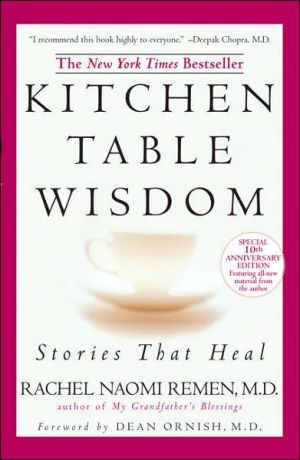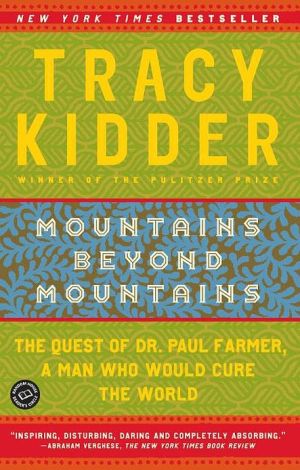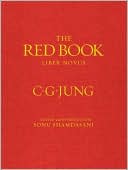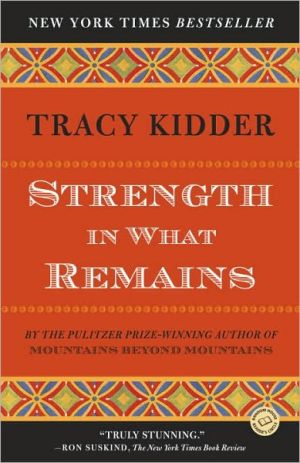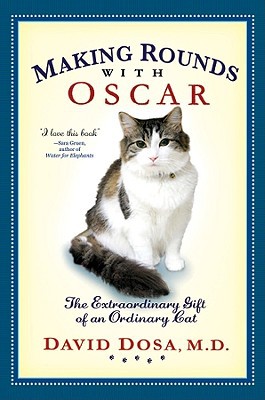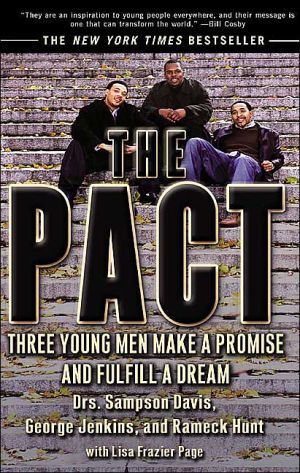Kitchen Table Wisdom: Stories That Heal
Praised by everyone from Bernie Siegel to Daniel Goleman to Larry Dossey, Rachel Remen has a unique perspective on healing rooted in her background as a physician, a professor of medicine, a therapist, and a long-term survivor of chronic illness. In a deeply moving and down-to-earth collection of true stories, this prominent physician shows us life in all its power and mystery and reminds us that the things we cannot measure may be the things that ultimately sustain and enrich our lives.
Search in google:
In this collection of deeply moving, true stories, Dr. Remen reminds listeners that the things that ultimately enrich life are the things that cannot be measured. Abridged. 3 CDs. Daniel Goleman, Ph.D. Rachel Naomi Remen is nature's gift to us, a genius of that elusive and crucial capacity, the human heart. She has much to teach us about healing, loving, and living.— author of Emotional Intelligence
Kitchen Table Wisdom\ Stories That Heal \ \ By Rachel Naomi Remen \ Riverhead Books\ Copyright © 1997 Rachel Naomi Remen\ All right reserved. \ ISBN: 1573226106 \ \ \ \ \ Chapter One\ \ \ Life\ Force\ \ \ \ Coherent, elegant, mysterious, aesthetic. When I first earned my degree in medicine I would not have described life in this way. But I was not on intimate terms with life then. I had not seen the power of the life force in everyone, met the will to live in all its varied and subtle forms, recognized the irrepressible love of life buried in the heart of every living thing. I had not been used by life to fulfill itself or been caught unaware by its strength in the midst of the most profound weakness. I had no sense of awe. I had thought that life was broken and that I, armed with the powerful tools of modern science, would fix it. I had thought then that I was broken also. But life has shown me otherwise.\ Many of the people who come to my office now as counseling clients have come because modern medicine has failed them in some way, or they have used up its power to help them and they do not know what else to do. They hope to find a way to heal, to cooperate with or even strengthen the life in them. After listening to hundreds and hundreds of their stories over the last twenty years I think I would have to say that most people do not recognize the strength of the life force in them or the many ways that it shows itself to them. Yet every one of us has felt its power. We who doubt are covered with the scars of our many healings.\ So when people first come, this is the place we usually start--talking about life itself, our attitude toward it, our experience of it, our trust or distrust of it. Developing an eye to see it, in others and in ourselves. In the beginning is the life force. After more than fifty years of living, I have learned it can be trusted.\ \ \ PLUM BLOSSOMS\ \ \ Many years ago in the midst of a shopping trip, I found myself in a store specializing in Japanese furniture, helping a friend who was furnishing his house. He had been rapidly taken over by the only salesperson, a tiny woman in a kimono who had grabbed his arm and begun a discussion of Japanese paintings with him in a loud and intense voice. Her head reached barely above his elbow but in spite of her size her manner made me uncomfortable and I drifted away toward the door, lurking behind chests and tonkus, waiting until he finished his purchases. I thought I had hidden successfully until, without warning, the woman turned and moved toward me, pointing as she came. I saw then that she was very old, possibly even deaf, and this perhaps explained her loudness. She took me by the arm and began to pull me through the showroom, encouraging me with little clicking noises and repetitions of "Come. You come." I tried to shake her off but for someone so small and frail her grip was strong. So I went along, followed by my friend, who was clearly amused by my struggle.\ She took us into a room in the back of the store, empty except for four scrolls, one on each wall, representing the seasons. Unlike the paintings in the showroom these were museum-quality. In one of them, an old and twisted branch bloomed with hundreds of tiny pink blossoms. The branch and the blossoms were covered with snow. It was exquisite.\ Leading me up to this, she said to me, "You see, you see? February! The plum blossom comes!" In her odd intense way she told me that the plum suffered because it was the first, it bloomed early, in February, often still in winter, in the hard and the cold. She touched the snow on the branch with her small arthritic hand, nodding her head vigorously. Looking intensely into my face and shaking my arm slightly, she said, "Plum blossom, the beginning. Like Japanese woman, plum blossom gentle, tender, soft ... and survive."\ I puzzled about this for a long time afterwards. As a physician, I thought I knew about survival, because after all I was in the survival business. I had known survival to be a matter of expertise, of skill and action, of competence and knowledge. What she had told me made no sense to me.\ This was confusing to me for other reasons as well. Like the plum blossoms, I too had come early. My mother had suffered from toxemia and I had been delivered by emergency cesarean section far below full-term weight. In February 1938, I had not been expected to live. All through my childhood I had been told that I had survived because of the invention of the incubator. For many years I had felt grateful for this technology, dependent upon it for my life. Now as a young pediatrician I was working in a premature intensive-care nursery using far more powerful technology to keep other babies alive. But what the old woman had said had made me wonder. Perhaps survival was not only a question of the skillful use of state-of-the-art technology, perhaps there was something innate, some strength in those tiny pink infants, that enabled both them and me to survive. I had never thought of that before.\ It reminded me of something that had happened one spring day when I was fourteen. Walking up Fifth Avenue in New York City, I was astonished to notice two tiny blades of grass growing through the sidewalk. Green and tender, they had somehow broken through the cement. Despite the crowds bumping up against me, I stopped and looked at them in disbelief. This image stayed with me for a long time, possibly because it seemed so miraculous to me. At the time, my idea of power was very different. I understood the power of knowledge, of wealth, of government, and the law. I had no experience with this other sort of power yet.\ Accidents and natural disasters often cause people to feel that life is fragile. In my experience, life can change abruptly and end without warning, but life is not fragile. There is a difference between impermanence and fragility. Even on the physiological level, the body is an intricate design of checks and balances, elegant strategies of survival layered on strategies of survival, balances and rebalances. Anyone who has witnessed the recovery from such massive and invasive interventions as bone marrow transplant or open heart surgery comes away with a sense of deep respect, if not awe, for the ability of the body to survive. This is as true in age as it is in youth. There is a tenacity toward life which is present at the intracellular level without which even the most sophisticated of medical interventions would not succeed. The drive to live is strong even in the most tiny of human beings. I remember as a medical student seeing one of my teachers put a finger in the mouth of a newborn and, once the baby took hold, gently lift him partway off the bed by the strength of his suck.\ That tenacity toward life endures in all of us, undiminished, until the moment of our death.\ Continues...\ \ \ \ Excerpted from Kitchen Table Wisdom by Rachel Naomi Remen Copyright © 1997 by Rachel Naomi Remen. Excerpted by permission.\ All rights reserved. No part of this excerpt may be reproduced or reprinted without permission in writing from the publisher.\ Excerpts are provided by Dial-A-Book Inc. solely for the personal use of visitors to this web site. \ \
\ From Barnes & NobleIn this deeply personal book, Dr. Rachel Naomi Remen synthesizes her experiences about healing as a physician, a professor of medicine, a therapist, and a long-term survivor. This augmented tenth anniversary edition offers a full cycle of thoroughly therapeutic stories.\ \ \ \ \ Dean Ornish, M.D.Enthusiastically praised by everyone from Bernie Siegel to Daniel Goleman to Larry Dossey, Rachel Remen has a unique perspective on healing rooted in her background as a physician, a professor of medicine, a therapist, and a long-term survivor of chronic illness. A deeply moving and down-to-earth collection of true stories, this prominent physician shows us life in all its power and mystery and reminds us that the things we cannot measure may be the things that ultimately sustain and enrich our lives. Kitchen Table Wisdom addresses spiritual issues-suffering, meaning, love, faith, courage, and miracles-in the language and authority of our own life experience.\ \ \ Bernie Siegel, M.D.This is a beautiful book about life, the only true teacher.\ \ \ \ \ Daniel Goleman, Ph.D.Rachel Naomi Remen is nature's gift to us, a genius of that elusive and crucial capacity, the human heart. She has much to teach us about healing, loving, and living.\ — author of Emotional Intelligence\ \ \ \ \ \ Larry Dossey, M.D.A great healer and a living saint.\ \ \ \ \ Deepak Chopra, M.D.I recommend this book highly to everyone.\ \ \ \ \ Publishers WeeklyRemen is one of a growing number of physicians exploring the spiritual dimension of the healing arts. "Coherent, elegant, mysterious, aesthetic," she writes. "When I first earned my degree in medicine I would not have described life in this way. But I was not on intimate terms with life then." Now Remen is awed by the vitality of the life force, which she witnesses through her work counseling cancer patients and their doctors at Commonweal, a cancer-help center in California, and through her keen eye for the depths of ordinary people. Remen tells of those who, having fallen ill, discovered previously untapped wells of fortitude and who, ironically, gained a peace of mind they had never known when well. She often turns common wisdom on its head. Discussing the meaning of suffering, she cites one woman who mourned the loss of her chest pains after corrective surgery. These pains had come whenever she had compromised her integrity; now her "inner advisor" was gone. Some of the most poignant stories here are of doctors whose professional code rejects overt displays of emotion. Both patients and doctors can come to care profoundly for one another, Remen believes. A heartfelt call for change as well as a display of compassionate and courageous thinking, this meditation will speak especially to those whose lives have been touched by illness. BOMC and One Spirit alternate selections; first serial rights to Family Circle and New Age Journal. (Aug.)\ \ \ \ \ Library JournalSpeaking as a counselor of 20 years for the chronically and critically ill patient, Remen (Univ. of California at San Francisco Medical Sch.) uses a classic metaphor for human communication, "across the kitchen table," to unfold life-affirming stories from her practice and her own personal experiences with Chron's disease. She writes inspirationally about a new vision of healing and living that incorporates the value of the soul. More than a manual on holistic medicine, this collection of case studies takes readers from the beginning of the "life force" through the judgment traps of modern life into an open-hearted mystery of embracing life at a friend's table. Acknowledging the individual's healing abilities in her advocacy of alternative therapies, Remen points out that healing occurs on many levels. Refreshingly, her instruction is based on a broader view of medicine that replaces disconnection with celebration of the joy of being a fully healed human.Rebecca Cress-Ingebo, Fordham Health Sciences Lib., Wright State Univ., Dayton, Ohio\ \
